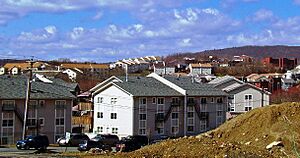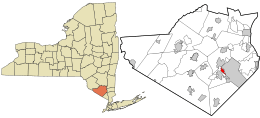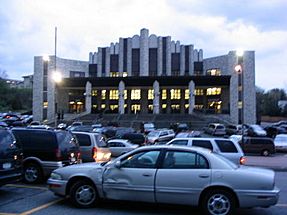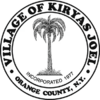Kiryas Joel, New York facts for kids
Quick facts for kids
Kiryas Joel, New York
קרית יואל
|
||
|---|---|---|
 |
||
|
||
| Nickname(s):
KJ
|
||

Location in Orange County and the state of New York.
|
||
| Country | ||
| State | ||
| County | Orange | |
| Town | Palm Tree | |
| Area | ||
| • Total | 1.49 sq mi (3.86 km2) | |
| • Land | 1.46 sq mi (3.79 km2) | |
| • Water | 0.03 sq mi (0.08 km2) | |
| Elevation | 842 ft (257 m) | |
| Population
(2020)
|
||
| • Total | 32,954 | |
| • Estimate
(2022)
|
38,998 | |
| • Density | 22,540.36/sq mi (8,704.41/km2) | |
| Time zone | UTC-5 (US EST) | |
| • Summer (DST) | UTC-4 (Eastern Daylight Time) | |
| Area code(s) | 845 | |
| FIPS code | 36-39853 | |
| GNIS feature ID | 0979938 | |
Kiryas Joel (Yiddish: קרית יואל, romanized: Kiryas Yoyel often locally abbreviated as KJ) is a village coterminous with the Town of Palm Tree in Orange County, New York, United States. The village shares one government with the Town. The vast majority of its residents are Yiddish-speaking Hasidic Jews who belong to the worldwide Satmar sect of Hasidism.
Kiryas Joel is the largest municipality and largest principal city in the Kiryas Joel-Poughkeepsie-Newburgh, NY Metropolitan Statistical Area, which in turn forms part of the New York Combined Statistical Area.
According to the Census Bureau's American Community Survey, Kiryas Joel has by far the youngest median age population of any municipality in the United States, and the youngest, at 13.2 years old, of any population center of over 5,000 residents in the United States.
Residents of Kiryas Joel, like those of other Haredi and Orthodox Jewish communities, typically have large families, and this has driven rapid population growth.
According to 2008 census figures, the village has the highest poverty rate in the nation. More than two-thirds of the residents live below the federal poverty line, and 40% receive food stamps. It is also the place in the United States with the highest percentage of people who reported Hungarian ancestry, as 18.9% of the population reported Hungarian descent in 2000.
History

Kiryas Joel is named for Joel Teitelbaum, the late rebbe of Satmar and driving spirit behind the project.
The Satmar Hasidim came from Satu Mare, Romania, known when under Hungarian rule as Szatmár. Teitelbaum, originally from Romania, rebuilt the Satmar Hasidic dynasty after World War II.
In 1947, Teitelbaum settled with his followers in the Williamsburg neighborhood of Brooklyn, a borough of New York City. By the 1970s, he decided to move the growing community to the Town of Monroe, a suburban location in Upstate New York that was more secluded from what he considered the harmful influences and immorality of the outside world, yet still close enough to the New York metropolitan area's commercial center. The land for Kiryas Joel was purchased in the early 1970s, and 14 Satmar families settled there in the summer of 1974. Monroe town officials initially expressed skepticism over Teitelbaum's and his followers' plans to build multi-family housing in Kiryas Joel, but they eventually allowed the town to incorporate in 1976. When he died in 1979, Teitelbaum was the first person to be buried in the town's cemetery. His funeral reportedly brought over 100,000 mourners to Kiryas Joel.
It is widely believed that no candidates run for the village's board or the school board unless approved by the grand rebbe, Aaron Teitelbaum. In 2001, Kiryas Joel held a competitive election in which all candidates supported by the grand rebbe were re-elected by a 55–45% margin.
In 2019, the village of Kiryas Joel separated from the town of Monroe, to become part of the town of Palm Tree, New York's first new town in 38 years. On July 1, 2018, Gov. Andrew Cuomo signed a bill to create Palm Tree, triggering elections for the first governing board. The new town had 10 elected positions on the November 2018 ballot, including a supervisor, four council members, and two justices to preside over a town court.
The name "Palm Tree" is a calque (translation) of the surname/family name of Joel Teitelbaum. In Yiddish, teitel (טייטל) means "date palm" and baum means "tree".
Geography
According to the United States Census Bureau, the village has a total area of 1.1 square miles (2.8 km2), and only a very small portion of the area (a small duck pond called "Forest Road Lake" in the center of the village) is covered with water.
Demographics
| Historical population | |||
|---|---|---|---|
| Census | Pop. | %± | |
| 1980 | 2,088 | — | |
| 1990 | 7,437 | 256.2% | |
| 2000 | 13,138 | 76.7% | |
| 2010 | 20,175 | 53.6% | |
| 2020 | 32,954 | 63.3% | |
| 2022 (est.) | 38,998 | 93.3% | |
| United States Census Bureau: | |||
| Largest ancestries (2000) | Percent |
|---|---|
| Hungarian | 18.9% |
| American | 8.0% |
| Israeli | 3.0% |
| Romanian | 2.0% |
| Polish | 1.0% |
| Czech | 0.3% |
| Russian | 0.3% |
| German | 0.2% |
| Languages (2010) | Percent |
|---|---|
| Spoke Yiddish at home | 91.5% |
| Spoke only English at home | 6.3% |
| Spoke Hebrew at home | 2.3% |
| Spoke English "not well", or "not at all" | 46.0% |
Kiryas Joel began with a 1977 founding population of 500 people. As of the census of 2000, there were 13,138 people, 2,229 households, and 2,137 families residing in the village. The population density was 11,962.2 inhabitants per square mile (4,618.6/km2). There were 2,233 housing units, at an average density of 2,033.2 per square mile (785.0/km2). The racial make-up of the village was 99.02% White, 0.21% African American, 0.02% Asian, 0.12% from other races, and 0.63% from two or more races. Hispanic or Latino of any race were 0.93% of the population.
Kiryas Joel has the highest percentage of people who reported Hungarian ancestry in the United States, as 18.9% of the population reported Hungarian ancestry in 2000. 3% of the residents of Kiryas Joel were Israeli, 2% Romanian, 1% Polish, and 1% European.
The 2000 census also reported that 6.3% of village residents spoke only English at home, one of the lowest such percentages in the United States. 91.5% of residents spoke Yiddish at home, while 2.3% spoke Hebrew. Of the Yiddish-speaking population in 2000, 46% spoke English "not well" or "not at all". Overall, including those who primarily spoke Hebrew and European languages, as well as primary Yiddish speakers, 46% of Kiryas Joel residents speak English "not well" or "not at all".
There were 2,229 households, out of which 79.5% had children under the age of 18 living with them, 93.2% were married couples living together, 1.6% had a female householder with no husband present, and 4.1% were non-families. 2.8% of all households were made up of individuals, and 2.1% had someone living alone who was 65 years of age or older. The average household size was 5.74, and the average family size was 5.84. In the village, the population was very young, with 57.5% under the age of 18, 17.2% from 18 to 24, 16.5% from 25 to 44, 7.2% from 45 to 64, and 1.6% who were 65 years of age or older. The median age was 15 years. For every 100 females, there were 116.3 males. For every 100 females age 18 and over, there were 118.0 males.
The village abides by strict Jewish customs, and its welcome sign (installed in 2010) asks visitors to dress conservatively and to "maintain gender separation in all public areas".
Transportation
Kiryas Joel has a very high rate of public transportation usage. Local transit within the area is operated by the Village of Kiryas Joel Bus System, and also has service to Manhattan and to the heavily Haredi Jewish-populated Williamsburg and Borough Park sections of Brooklyn.
Education
Most students go to private religious schools; in 2021 there were about 12,000 students attending them. In 2020 the area had almost 24 such schools. In 1994 Kiryas Joel had 5,000 children in the K-12 level with the majority going to private yeshivas and about 200 going to the public special education school.
The public Kiryas Joel School District has a school for special education students. Before 1985, special education students were taught by public school teachers in separate classes within yeshivas, and between 1985 and 1989 special education students were taught in Monroe–Woodbury Central School District facilities.
See also
 In Spanish: Kiryas Joel para niños
In Spanish: Kiryas Joel para niños
- New Square, New York − an all-Hasidic village in a neighboring county
- Kaser, New York − an all-Hasidic village in a neighboring county
- Kiryas Tosh, Quebec − an all-Hasidic community in Quebec, Canada
- Qırmızı Qəsəbə
- Shtetl




